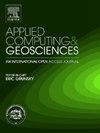Natural fracture network model using Gaussian simulation and machine learning algorithms
IF 3.2
Q2 COMPUTER SCIENCE, INTERDISCIPLINARY APPLICATIONS
引用次数: 0
Abstract
In this paper, a fracture network model is proposed to enhance the understanding of subsurface fracture characterization. The model combines geostatistical methods such as sequential indicators and Gaussian simulations. The model uses data from natural faults in Kazakhstan to predict the segment, azimuth, and length of fractures in unknown areas. The model is validated by comparing the simulated fracture networks with the original fracture data and by hiding some regions within the fracture network. The results show that the geostatistical methods perform better than the machine learning algorithm for azimuth prediction, while the machine learning algorithm performs better for length prediction. In addition, the validation of the fracture network model is conducted by comparing the production curve profiles in the tracer test setting. They are in good agreement.
自然裂缝网络模型采用高斯仿真和机器学习算法
本文提出了一个裂缝网络模型,以增强对地下裂缝特征的理解。该模型结合了序贯指标和高斯模拟等地统计学方法。该模型使用哈萨克斯坦天然断层的数据来预测未知区域裂缝的分段、方位角和长度。通过将模拟裂缝网络与原始裂缝数据进行比较,并隐藏裂缝网络中的某些区域,验证了模型的有效性。结果表明,地统计学方法在方位预测方面优于机器学习算法,而机器学习算法在长度预测方面优于机器学习算法。此外,通过对比示踪剂测试设置中的生产曲线剖面,对裂缝网络模型进行了验证。他们意见很一致。
本文章由计算机程序翻译,如有差异,请以英文原文为准。
求助全文
约1分钟内获得全文
求助全文
来源期刊

Applied Computing and Geosciences
Computer Science-General Computer Science
CiteScore
5.50
自引率
0.00%
发文量
23
审稿时长
5 weeks
 求助内容:
求助内容: 应助结果提醒方式:
应助结果提醒方式:


